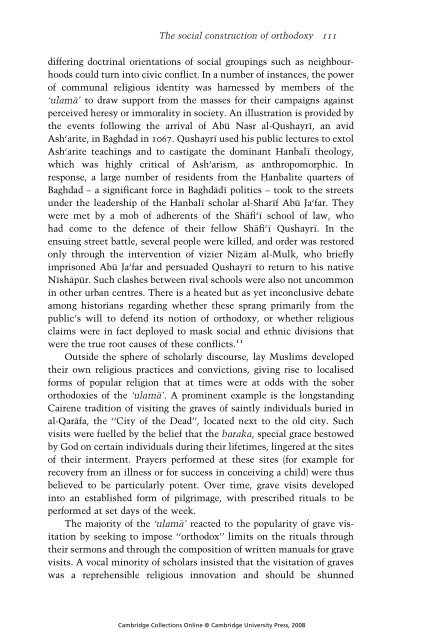Abdal Hakim Murad - The Cambridge Companion to Islamic Theology
You also want an ePaper? Increase the reach of your titles
YUMPU automatically turns print PDFs into web optimized ePapers that Google loves.
<strong>The</strong> social construction of orthodoxy 111<br />
differing doctrinal orientations of social groupings such as neighbourhoods<br />
could turn in<strong>to</strong> civic conflict. In a number of instances, the power<br />
of communal religious identity was harnessed by members of the<br />
‘ulama’ <strong>to</strong> draw support from the masses for their campaigns against<br />
perceived heresy or immorality in society. An illustration is provided by<br />
the events following the arrival of Abu Nas _<br />
r al-Qushayrı, an avid<br />
Ash‘arite, in Baghdad in 1067. Qushayrı used his public lectures <strong>to</strong> ex<strong>to</strong>l<br />
Ash‘arite teachings and <strong>to</strong> castigate the dominant H _<br />
anbalı theology,<br />
which was highly critical of Ash‘arism, as anthropomorphic. In<br />
response, a large number of residents from the H _<br />
anbalite quarters of<br />
Baghdad – a significant force in Baghdadı politics – <strong>to</strong>ok <strong>to</strong> the streets<br />
under the leadership of the H _<br />
anbalı scholar al-Sharıf Abu Ja‘far. <strong>The</strong>y<br />
were met by a mob of adherents of the Shafi‘ı school of law, who<br />
had come <strong>to</strong> the defence of their fellow Shafi‘ı Qushayrı. In the<br />
ensuing street battle, several people were killed, and order was res<strong>to</strong>red<br />
only through the intervention of vizier Niz _<br />
am al-Mulk, who briefly<br />
imprisoned Abu Ja‘far and persuaded Qushayrı <strong>to</strong> return <strong>to</strong> his native<br />
Nıshapur. Such clashes between rival schools were also not uncommon<br />
in other urban centres. <strong>The</strong>re is a heated but as yet inconclusive debate<br />
among his<strong>to</strong>rians regarding whether these sprang primarily from the<br />
public’s will <strong>to</strong> defend its notion of orthodoxy, or whether religious<br />
claims were in fact deployed <strong>to</strong> mask social and ethnic divisions that<br />
were the true root causes of these conflicts. 11<br />
Outside the sphere of scholarly discourse, lay Muslims developed<br />
their own religious practices and convictions, giving rise <strong>to</strong> localised<br />
forms of popular religion that at times were at odds with the sober<br />
orthodoxies of the ‘ulama’. A prominent example is the longstanding<br />
Cairene tradition of visiting the graves of saintly individuals buried in<br />
al-Qarafa, the ‘‘City of the Dead’’, located next <strong>to</strong> the old city. Such<br />
visits were fuelled by the belief that the baraka, special grace bes<strong>to</strong>wed<br />
by God on certain individuals during their lifetimes, lingered at the sites<br />
of their interment. Prayers performed at these sites (for example for<br />
recovery from an illness or for success in conceiving a child) were thus<br />
believed <strong>to</strong> be particularly potent. Over time, grave visits developed<br />
in<strong>to</strong> an established form of pilgrimage, with prescribed rituals <strong>to</strong> be<br />
performed at set days of the week.<br />
<strong>The</strong> majority of the ‘ulama’ reacted <strong>to</strong> the popularity of grave visitation<br />
by seeking <strong>to</strong> impose ‘‘orthodox’’ limits on the rituals through<br />
their sermons and through the composition of written manuals for grave<br />
visits. A vocal minority of scholars insisted that the visitation of graves<br />
was a reprehensible religious innovation and should be shunned<br />
<strong>Cambridge</strong> Collections Online © <strong>Cambridge</strong> University Press, 2008



